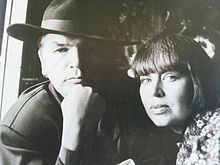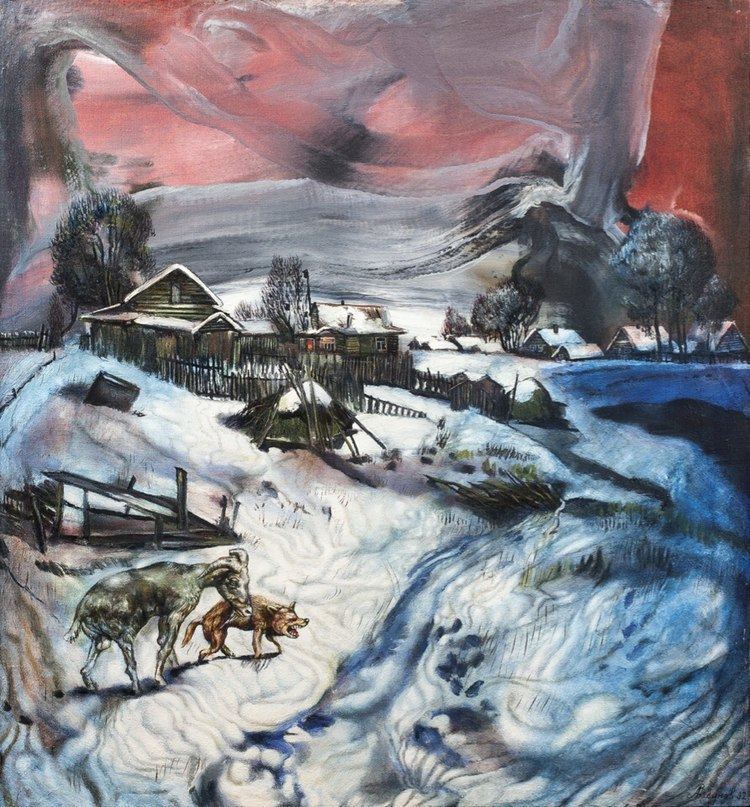Nationality Russian Role Artist | Name Vladimir Lisunov Known for Painting | |
 | ||
Born 21 March 1940 Leningrad, USSR Died July 27, 2000, Saint Petersburg, Russia | ||
Education Imperial Academy of Arts | ||
Vladimir Lisunov (Russian: Владимир Евгеньевич Лисунов) (21 March 1940 – 27 July 2000) was a Russian nonconformist artist, member of the Leningrad unofficial art tradition of the 1960s–80s, poet, philosopher, romantic, mystic. Known as Lis among artists and close friends.
Contents
- Childhood
- Studies
- Work
- Creative work
- Destruction of exhibitions
- Ostrov group
- Changes
- Death
- Personality and style
- Personal life
- Personal Exhibitions
- With The Island Group
- Jointly with the Association of Experimental Fine Arts
- Apartment Exhibitions
- Other Joint Exhibitions
- The works in museums and collections
- Poetry
- Filmography
- Literature
- References

Childhood
Vladimir Lisunov was born in Leningrad on the spring equinox 21 March 1940. His father, Evgenii Ivanovich Lisunov (of Greek origin) was a professional financial expert, as was his mother Valentina Filipovna Lisunova (maiden name Minina) His sister Galina Evgenievna Lisunova was born in 1935.
Vladimir Lisunov's early childhood took place during the war years, and he and his mother and sister had to live through the Nazi Siege of Leningrad, and also through bombardment and air raids of the besieged city. At the age of nine he began drawing, learnt to play the violin and wrote poetry, but by the age of twelve he had realised that his vocation was painting.
Studies
He finished secondary school in 1957. In 1958 he graduated from a children's art school in drawing, painting, sculpture and the history of art, and began studying in the faculty of painting at the Leningrad Repin Institute of Arts. His teachers there included Boris Ioganson, Smirnov and Kiparisov.
Work
He worked in the Leningrad Kirov Theatre of Opera and ballet, where he created sets, sketches of costumes, and make upmake up. He made several sketches of costumes for the ballerinas Natalia Makarova and Alla Osipenko. He earned extra money by making toys out of papier-mâché, which he decorated with paint. He also decorated porcelain in the Leningrad Porcelain Factory.
Creative work
Vladimir Lisunov spent his whole life in constant creative searching. He was always experimenting and honing his painting technique, and explored various themes. Some of Lisunov's paintings are full of mystical images and bring us in to other worlds, whereas others depict stories from the Bible or rural landscapes. He also created a series of drawings called: "Astral wanderings of the soul", "Landscapes of the soul", "Portrait of a woman", "Divas", "Aerial nudes", "Portraits of friends" and "Commuter train people".
Wishing to distract himself from the harsh Soviet reality, Vladimir Lisunov immersed himself in mysticism and occultism, studying works by Papus, Blavatsky, and Castaneda, which had been copied out by hand, and this undoubtedly was reflected in his work.
Not having his own studio and confined by his living conditions, Lisunov painted some of his pictures on a stairway landing, enduring hostile looks from passing neighbours. On his days off he often went out to the countryside in the Leningrad region, where he painted his series of landscapes called "Little villages" and "Winter scenes". As regards Lisunov's style, he called himself a mystic symbolist.
Destruction of exhibitions
Vladimir Lisunov's work went against Soviet Ideology's notions of art. For this reason he was forbidden to work as an artist. Attempts to organise official exhibitions of his work were unsuccessful. He was turned down even at the very initial stages of negotiations. In the mid 1960s, having begun to exhibit his work illegally, he came under the radar of the KGB, and as a result his personal exhibitions were smashed up, and his paintings barbarically destroyed by members of the militia. But in spite of the bans, threats and hounding on the part of the KGB, Vladimir Lisunov continued to work, and in 1970–71 took part in several joint exhibitions in the studio of the artist Vladimir Ovchinnikov, which were also smashed up by members of the militia. In 1975, Lisunov planned to take part in an exhibition of avant-gardists in the "Nevsky Palace of Culture", but on the eve of the opening he was arrested by members of the KGB, and as a result he spent several days in a cell in the Bolshoy Dom on Liteyny Avenue. In this way, Vladimir Lisunov's participation in the exhibition was sabotaged. But it was there, in the confines of the KGB, sitting in a cell, Vladimir Lisunov used a pencil to draw on paper a sketch which he later used when painting the picture 'The fugitive', which became a 'calling card' of his work. Unfortunately, most of Vladimir Lisunov's paintings were destroyed by members of the Soviet Militia, with the sanction of the KGB, during the destruction of his exhibitions.
Right up until 1985, Vladimir Lisunov was forced to be in a constant battle with the authorities as he attempted to assert his right to exhibit his works.
"Ostrov" group
In 1985, Vladimir Lisunov joined an independent creative association of Leningrad artists called "Ostrov" (English: "The Island").
Changes
In the same year 1985, with the beginning of perestroika in the Soviet Union, changes began, and forbidden artists began to be treated with more tolerance. They were given permission to exhibit their work, and Vladimir Lisunov got the chance to take part in official exhibitions. During this time he worked a lot, and made plans for future creative work, but a tragic occurrence was to destroy everything.
Death
On 27 July 2000 Vladimir Lisunov's life was cut short at the hand of a murderer.
The crime was never solved.
Personality and style
Contemporaries who knew Lisunov well called him Lis, and remember him as a vivid cult figure in the Leningrad underground. Naturally handsome, with a slim figure, he wore a floor-length overcoat and a scarlet scarf thrown carelessly around his neck. His head was always adorned with a wide-brimmed hat. That was his style, which was an inextricable part of his personality. It was a style which he did not change over the course of his whole life, and which was his 'calling card'. People who only saw Vladimir Lisunov once remembered his appearance for many years.
Personal life
In 1971 Vladimir Lisunov married Irina Sarapulova, a student at the Mukhina Art and Industry Academy, and she became his Wife, Friend and Muse for the rest of his life.
Irina Sarapulova currently lives in Saint Petersburg, promotes Vladimir Lisunov's work, and organises exhibitions.
Personal Exhibitions
With "The Island" Group
Jointly with the Association of Experimental Fine Arts
Apartment Exhibitions
Other Joint Exhibitions
The works in museums and collections
The works of artist Vladimir Lisunov can be found in private collections in St Petersburg, Moscow, as well as in Estonia, France, Germany, Switzerland, Denmark, Norway, Netherlands, Italy, Finland, Poland, US, Canada, Australia and Ireland.
Poetry
In 2008 the publishing house 'Borey-Art', released a collection of Lisunov's poetry which contained fifty two poems and three long poems.
